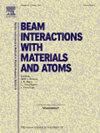用分子动力学方法研究辐照下铁镍合金缺陷族的形成
IF 1.4
3区 物理与天体物理
Q3 INSTRUMENTS & INSTRUMENTATION
Nuclear Instruments & Methods in Physics Research Section B-beam Interactions With Materials and Atoms
Pub Date : 2025-05-07
DOI:10.1016/j.nimb.2025.165731
引用次数: 0
摘要
实验中普遍观察到FCC FeCrNi合金辐照后形成含有层错四面体(SFT)的缺陷群,其周围环绕着几个小黑点。然而,相关的形成机制到目前为止还没有研究清楚。在这项工作中,基于分子动力学(MD)和透射电子显微镜(TEM)图像模拟,在原子尺度上探索了在完美的FCC-FeCrNi模型或包含预先存在的SFT的FCC-FeCrNi模型中由位移级联诱导的这种缺陷群的形成,并给出了与实验报告相同的结果。在后一种情况下,观察到SFT在与级联相互作用过程中通过吸收级联诱导的空位和周围三维纳米级间隙团簇或环的形成而演变。此外,弹性常数计算表明C11、C12和C44随缺陷组的形成而减小,应力-应变曲线表明缺陷组对边缘位错滑动的钉住作用比完美的SFT更强。这些结果表明,在预测FCC FeCrNi合金辐照后的组织演变和力学性能时,应考虑缺陷群的形成。本文章由计算机程序翻译,如有差异,请以英文原文为准。
Formation of a defect group in an FeCrNi alloy under irradiation investigated by molecular dynamics
Formation of a defect group containing a stacking fault tetrahedron (SFT) surrounded by several small black dots in an FCC FeCrNi alloy after irradiation has been generally observed experimentally. However, the related formation mechanism is not investigated clearly until now. In this work, based on molecular dynamics (MD) and transmission electron microscopy (TEM) image simulations, formation of such a defect group induce by displacement cascades in a perfect FCC-FeCrNi model or an FCC-FeCrNi model containing a pre-existing SFT, has been explored at atomic scale, presenting the same results to experimental reports. In the latter case, evolution of a SFT during its interaction with cascades through the absorption of cascade induced vacancies and formation of surrounding 3D nano-scale interstitial clusters or loops, have been observed. Furthermore, the elastic constants calculations imply the decrease of C11, C12 and C44 with formation of a defect group while the stress–strain curves indicate the stronger pinning effects of a defect group than a perfect SFT to the gliding of edge dislocations. All these results indicate that formation of defect groups should be taken into the consideration for prediction of structure evolution and mechanical properties of an FCC FeCrNi alloy after irradiation.
求助全文
通过发布文献求助,成功后即可免费获取论文全文。
去求助
来源期刊
CiteScore
2.80
自引率
7.70%
发文量
231
审稿时长
1.9 months
期刊介绍:
Section B of Nuclear Instruments and Methods in Physics Research covers all aspects of the interaction of energetic beams with atoms, molecules and aggregate forms of matter. This includes ion beam analysis and ion beam modification of materials as well as basic data of importance for these studies. Topics of general interest include: atomic collisions in solids, particle channelling, all aspects of collision cascades, the modification of materials by energetic beams, ion implantation, irradiation - induced changes in materials, the physics and chemistry of beam interactions and the analysis of materials by all forms of energetic radiation. Modification by ion, laser and electron beams for the study of electronic materials, metals, ceramics, insulators, polymers and other important and new materials systems are included. Related studies, such as the application of ion beam analysis to biological, archaeological and geological samples as well as applications to solve problems in planetary science are also welcome. Energetic beams of interest include atomic and molecular ions, neutrons, positrons and muons, plasmas directed at surfaces, electron and photon beams, including laser treated surfaces and studies of solids by photon radiation from rotating anodes, synchrotrons, etc. In addition, the interaction between various forms of radiation and radiation-induced deposition processes are relevant.

 求助内容:
求助内容: 应助结果提醒方式:
应助结果提醒方式:


